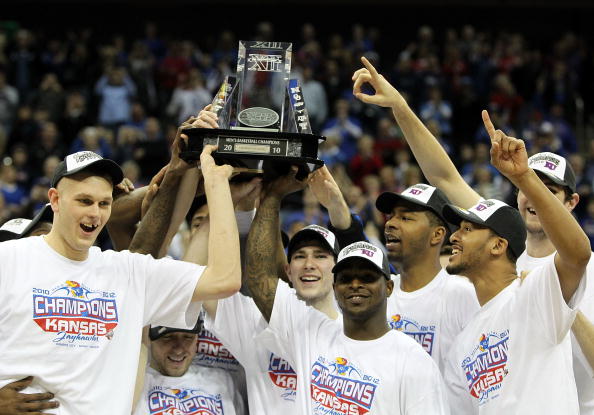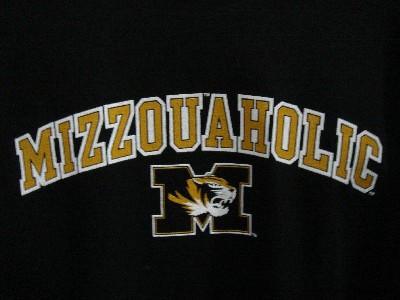Winners & Losers From Conference Realignment (so far)
Posted by rtmsf on June 18th, 2010Andrew Murawa is the RTC correspondent for the Pac-10 and Mountain West conferences and an occasional contributor.
With the news on Thursday that Utah has received and accepted the invitation to become the 12th member of the Pac-10, it looks like the college sports realignment apocalypse has been averted for the summer. There may be further movement on down the line, but all signs point to a relative period of calm after weeks of frantic scrambling from all corners of the country. While it was a pale substitute for actual on-court play, we did have plenty of intrigue and suspense, action and strategy, and winners and losers. Now it’s just a matter of sorting out who was what.
The Greatest and Still Champion
Texas
Texas definitely fits in the “winner” category, but I think lumping them in with these other schmucks below would be selling them short. And I’m sure they would agree. The Longhorns played this about as well as could be played, and they got everything they wanted out of it. The Big 12 keeps their television deal with ESPN (which doesn’t expire until 2016), but only has to share the proceeds among ten schools rather than twelve. The conference received a promise from Fox for a new deal when their current deal expires, with exponential increases in revenue on tap. And, on top of all that, Texas retains the right to sell local television rights and is free to explore its plans for a Longhorn television network. Bonus: in the process of trying to keep the Longhorns in the Big 12, there are reports that the neediest institutions in the bunch agreed to a plan that sent all of the money that Colorado and Nebraska owe the conference in buyout fees (reported to be somewhere between $10 and $40 million, depending on the source) to Texas, Texas A&M and Oklahoma. So, in the span of a week, without losing any of their traditional rivals in the Big 12 South, Texas goes from generating somewhere in the $12 million range in television revenues to earning an estimated $20-25 million annually. And, that’s not even the best of it. In the process, it became painfully obvious that Texas is the big dog in the conference and the other schools (aside from Texas A&M) are in some manner, just riding coattails. Schools like Oklahoma and Texas Tech made it clear that they were just going to do whatever Texas did, while others, like Missouri, Kansas, Iowa State and Baylor, had their futures twisting in the wind, reliant on Texas to save them. If the Longhorns had gone to the Pac-16, they would have just been one of the sixteen there. By staying at home, they are clearly the kings of their conference.
The Winners
Texas A&M
The Aggies showed themselves as the one school in the conference that had plans of their own regardless of Texas. While Oklahoma and others were happy to just do whatever Texas decided, A&M talked to the SEC, and by all reports, actually had an offer to join that conference. But, in the end when they could have run off and forced Texas’ move west, the Aggies agreed to stick around and share in the league’s windfall, excellent news for an athletic department that was $16 million in debt, and even better for a school whose once proud football program has fallen on hard times in the past decade.
Big 12 Basketball
Without a doubt, the Big 12 became a better basketball conference overnight. Over the last nine years, both Colorado and Nebraska have had an average finish of around ninth in the conference. Nebraska has never won an NCAA tournament game. Colorado has only had two NCAA tournament berths in the last 40 years. So as far as the basketball side of the equation goes, this is addition by subtraction at its finest. As the conference makes the transition to an 18-game schedule in which each team will play a full home-and-home round-robin, they will no longer have to worry about games against the Buffs or Huskers dragging down their RPI. Every night in the conference will be tough sledding, but every team in the conference will also have a better chance to build their resume for postseason play.
Chip Brown and Orangebloods.com
Chip Brown has been the point-man on conference realignment for about two weeks now. He broke the original story about Texas dragging five other Big 12 schools to the Pac-10, and when Texas blinked in the 11th hour, it was Brown who had that story first as well, even in the face of ESPN reporting the opposite. In the process, Brown, a former writer for the Dallas Morning News, has seen his Twitter followers increase exponentially, and the profile of Orangebloods.com, a Longhorn Rivals site of which he is part owner, has jumped from something that was only known amongst the most attentive Longhorn fans to an important resource for those of us following this story.
Utah
The Utes received just $1.2 million in television revenue from their association with the Mountain West Conference. Presently Pac-10 schools earn somewhere in the $10-$12 million neighborhood from their television contracts, and with the Pac-10 set to negotiate a new television deal which will begin the 2011-12 season, the Utah athletic department stands to make a nice chunk of change for very little trouble. While the basketball program is going through a rough patch presently, it wouldn’t surprise anyone to see the Utes be right in the thick of things in the Pac-10 football chase immediately.
ABC/ESPN and Fox Sports
Both networks stepped in to help save the Big 12. ABC/ESPN agreed to keep their current contract with the Big 12, allowing the ten remaining members to split the revenues that had previously been divided amongst twelve. Fox Sports also agreed to large increases in their agreement with the Big 12 which expires next offseason. If Texas had bolted for the Pac-10 along with five other Big 12 members, both ESPN and Fox Sports would have had a major bidding war on its hands for the rights to the new Pac-16 conference television deal. The breakup of the Big 12 would likely have meant other moves by the Big Ten or SEC or ACC, moves that could have resulted in their contracts needing to be reworked. In the short term, both entities probably overpay for the Big 12 rights, but they saved themselves plenty of cash in the long term.
Big Ten
While it may have appeared to be the first rat on the way out before the ship went down, Nebraska’s move to the Big Ten makes a lot of sense, at least football-wise. Adding the Huskers gives the Big Ten four iconic football programs, the ability to hold a championship game and a fanbase that will eat up anything Huskers on the Big Ten Network. And, passing on Missouri is probably the right move as well. Picking up one Big 12 team brings the Big Ten to 12 schools, and allows them to take their time with any additional expansion they may be interested in, while getting the benefits of the 12th team. If the Big Ten chooses to pursue further expansion, it will be mostly focused on Big East teams, including the great white whale, Notre Dame.
The Losers
Missouri
Since the Big Ten announced that it was exploring expansion as a possibility, Mizzou may have had their feet in the Big 12, but their minds were definitely in the Big Ten. Figuring they were a strong geographic and academic match with the Big Ten and that they added the St. Louis and Kansas City media markets, Missouri administrators figured they were a lock for a Big Ten invite. But, when things started moving fast with the Pac-16 rumors, and with Mizzou still unable to garner the affection of the Big Ten who was busy checking out that hot little number Nebraska, they were forced to backpedal and make sure that everyone associated with the university knew to say that Missouri was already in a very happy relationship with the Big 12. And, while Texas mulled their potential move to the Pac-16, Mizzou was looking at a future that included neither the Big 12 nor the Big Ten. In the end, they got a reprieve from Austin, and in return are locked into the Big 12 for the foreseeable future despite their longstanding displeasure with the appropriation of funds in the conference, a situation that just got far, far worse. So, basically, Missouri comes across as a school that thought itself a lot hotter than anyone else did, waiting on a Big Ten invitation that was never going to come only to go slinking back to the Big 12 after nearly being left to fend for itself, ready to give Texas whatever it wanted so long as they could just stick around. Pathetic, really.
Colorado
During last season’s disastrous football season in Boulder, it came to light that in head football coach Dan Hawkins’ contract was a clause detailing, upon early termination of his contract, approximately $1 million worth of buyout funds for every year remaining on the contract, at a time when Hawkins still had three years on his deal. A major reason why Hawkins remains the head coach at Colorado is because the athletic department couldn’t afford spending the $3 million to buy him out. Fast forward to the offseason, there is an offer on the table from the Pac-10 to take Colorado from the Big 12 along with Texas and the other schools, but once Texas legislative members started making noise about wanting to substitute Baylor for Colorado in the deal, the CU athletic department got spooked and, rather than wait for the official announcement from Texas that the conference was indeed dead, CU got out in front of the deal and announced their intentions to join the Pac-10. A couple days later, Texas backs out, and Colorado is now in a situation where not only will they forfeit 80% of their television revenues for their remaining time in the Big 12, they also will need to pay the Big 12 (well, really, just Texas, Oklahoma and Texas A&M) additional buyout fees at a time when they couldn’t even afford $3 million to can a failing head coach. And, to top it off, their travel budget just increased as well.
Mountain West
For the span of a weekend or so, the MWC was a very good 10-team conference with at least an argument that they deserved an automatic BCS bid. On the horizon was a chance to pick off some of the Big 12 leftovers once Texas and the gang headed to the Pac-16. Then, at the last minute, Texas changed its mind, and the writing was on the wall that not only would they not be adding any Big 12 schools, but Utah was on the way out the door. While adding Boise State eases the pain somewhat, the loss of Utah – a program with not only a couple BCS bowl bids in its recent history but also a Final Four appearance in the not-too-distant past – is a major blow to the conference, dashing their dreams of the big time.
Baylor
The Bears had a weird couple of weeks. First, they were going to be left behind when Texas pulled out of town for the Pac-16. Then, via Ann Richards’ ghost, they were going to be rescued and brought along in place of Colorado. Then, word came down that Cal and Stanford, among others in the Pac-10, wanted absolutely nothing to do with their religious affiliation, and Baylor was back on the outs again. While they were making plans for life without the Big 12, word came out that even Texas Christian was uninterested in sharing the Mountain West with their former Southwest Conference chums. And, in the end, Baylor got bailed out by Texas, and only had to give Texas everything they wanted for the privilege.
WAC
While Missouri, Colorado, Baylor and the Mountain West all came out losers at the end of the process, they all at least have something to show for it. Mizzou and Baylor (not to mention Iowa State, Kansas and Kansas State) are still in a BCS conference, and almost overnight, their television revenues increase as payment for a week or two of stress. Colorado probably jumped the gun too early, but they wound up in another BCS conference, and probably the conference that they wanted to be in. And the Mountain West was on top of the world for a weekend, and when it all came crashing down, they wound up as more or less the same conference they were when they started. But the WAC? Its flagship football program is gone, and there are absolutely no suitable replacements on the horizon anywhere. For basketball fans, however, you won’t really notice much of a difference. Did the Broncos even field a basketball team?
To Be Determined
Dan Beebe
Beebe’s goal as the Big 12 commissioner was, basically, to be able to still have a job after next season. He’s done that. The Big 12 is saved for now. However, there are plenty of questions about the long term viability of the conference, given that Beebe’s plan to save the Big 12 amounted to little more than giving Texas whatever it wanted. The main problem the Big 12 North schools had with the conference was the inequitable sharing of revenues, and in giving Texas the keys to the conference, Beebe’s plan only exacerbated that situation. And, now the precedent has been set: whenever Texas wants something, the best way for the Big 12 to deal with it is to give it to them. Maybe the next time the SEC comes calling on Texas A&M, the Sooners are willing to go east with them and get out under the thumb of Austin, although that will be at least 10 years down the road. For now, give Beebe plenty of credit for doing what seemed impossible as recently as Sunday, saving the Big 12. But we’ll have to save a final determination on Beebe’s success until later.
The Pac-10
If a month ago, you had been told that the Pac-10 had expanded to twelve by adding Colorado and Utah, most people would have seen that as a good move for the conference, adding the two schools with the most in common with the other Pac-10 institutions: large, non-religious research institutions in large western cities. However, on the heels of missing out on Texas, Oklahoma, Texas A&M, et al, there is a feeling that the Pac-10 failed. While this didn’t turn out quite as well as it might have for the conference, this is by no means a loss. They still get their football championship game, they can still pursue a conference television network, and they have added a couple large media markets along the way. Sure, they didn’t get the home run it looked like they might get, but a double off the fence is nothing to complain about.
Nebraska
On the surface, Nebraska will fit in with the Big Ten culture just fine. But let’s be honest, Nebraska is all about football. While they will continue to grab every high school football prospect out of the state of Nebraska, to paraphrase Barry Alvarez, their hearts and minds may come from Nebraska, but their legs and hands better come from Texas and Florida. In pulling out of the Big 12, Nebraska will have to reorient its recruiting away from Texas and towards the Big Ten territory. It remains to be seen how successful they can be competing in recruiting against traditional Big Ten powers, and how successful they can be on the national scene just pulling the majority of its players from within the Big Ten footprint.














































